Discover the Amazing Types of Owls in North America
Updated: Nov. 01, 2023
Watch your backyard come to life as amazing owl species swoop through the night skies. Get to know the types of owls that live in North America.
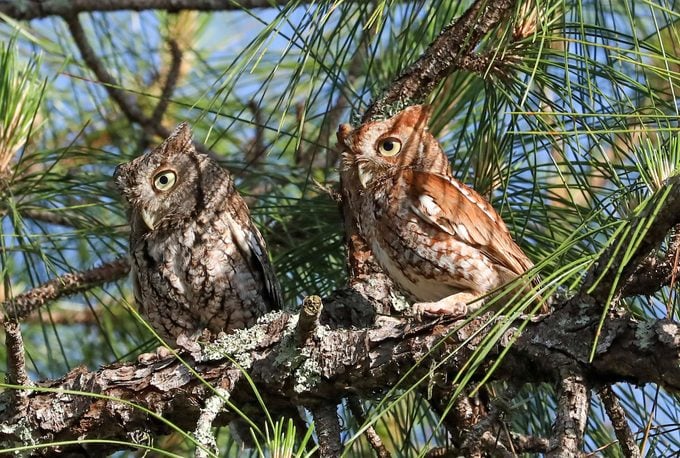
It’s no secret that owls are a hot topic in the bird world. These birds of prey are fascinating, unique and rarely seen due to their nocturnal tendencies. Owls aren’t clamoring for a spot at feeders like other birds, and that’s why everyone jumps at the chance to see one. So if owls aren’t visiting your backyard, where are they? Many of the most interesting types of owls can only be found in certain areas of the continent. Think Rocky Mountains, deserts of the southwest, conifer woods in the northwest and spruce forests of the eastern U.S. into Canada. Nearly 20 owl species live in North America. Let’s find out more about these amazing birds and where they can be spotted.
Don’t miss these outstanding pictures of owls.
Great Gray Owl
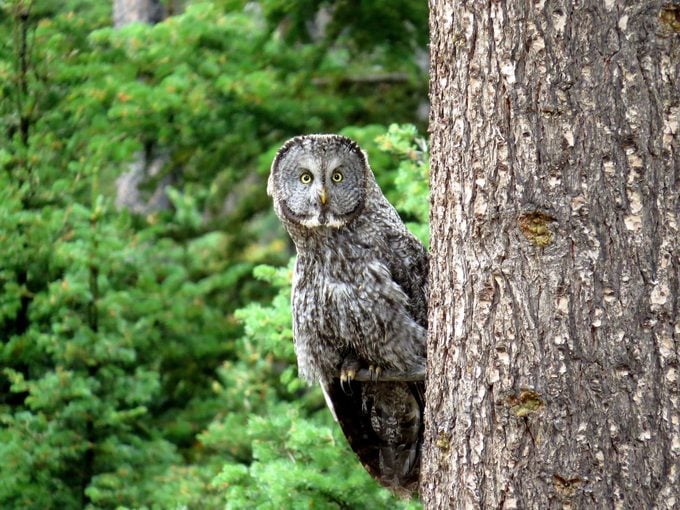
Owls come in all sizes. The largest owl out there is the great gray owl, which can reach up to 2-1/2 feet in length! This big, charismatic species of the northern boreal forests has the most compelling hunting strategy. The owl has dish-shaped feathers that surround its face, funneling sound to its ears. Its sense of hearing is so acute that the great gray owl can hunt by sound alone, hearing the motion of voles and lemmings beneath the surface of the snow.
Snowy Owl
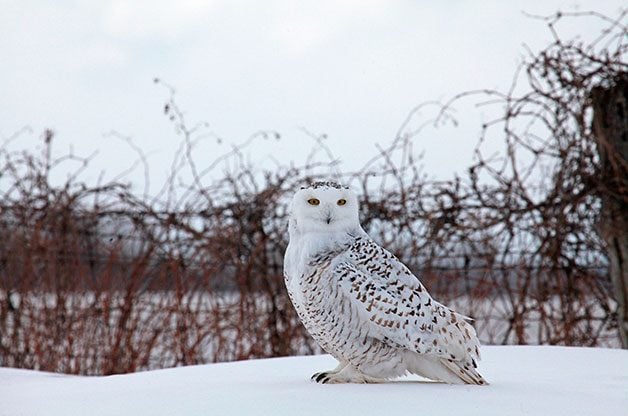
The heaviest owl is the snowy owl, which weighs somewhere between 3 and 5 pounds. North of the great swath of boreal forest lies the treeless expanse of Arctic tundra where this stunning owl species lives year-round. Large and powerful, the snowy owl subsists mostly on small mammals. Every few years the population of their prey (voles and lemmings) collapses, forcing large numbers of snowies out of the Arctic. They move south by the hundreds or thousands and appear in many states of the Lower 48. The winter of 2013-’14 was one such occasion, and snowy owl sightings were reported across the United States.
Elf Owl and Ferruginous Pygmy-Owl
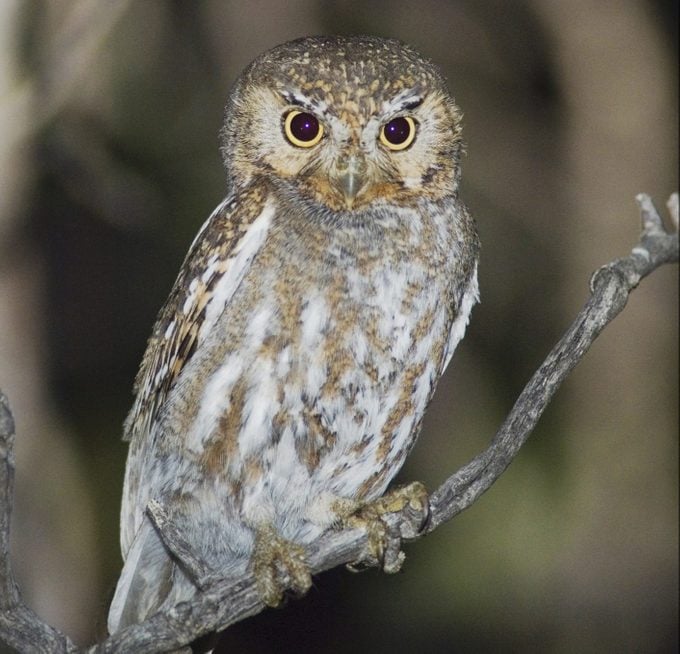
Compare both of those owl species to the smallest owl around: the elf owl. These owls are sparrow-sized at just about 5-1/2 inches long, and they weight about as much as a golf ball. Now that’s tiny! The elf owl and the ferruginous pygmy-owl, which is no larger than an American robin, make their homes in the desert. As cavity nesters, they often use holes in giant cactus. The petite, brown-eyed flammulated owl spends the summer in the mountain pine forests of the southwest.
Learn how to attract owls to nest in your yard.
Burrowing Owl
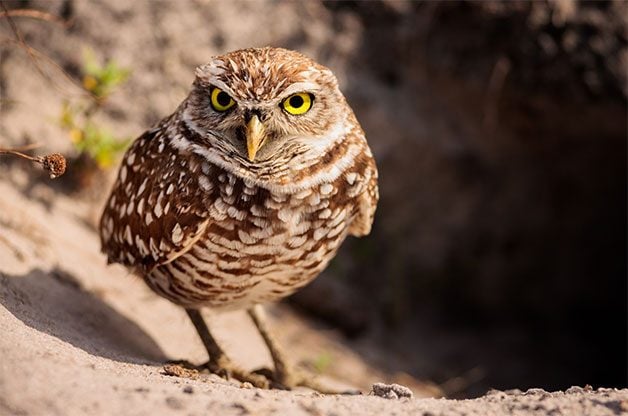
An oddity in the owl world, burrowing owls are among the few species to nest underground in grasslands and deserts. The southern Florida populations dig their own chambers, while burrowing owls in the Southwest rely on holes dug by other animals, including prairie dogs, badgers and ground squirrels. Look for burrowing owls perched on fence posts or other low perches, swiveling their heads from side to side. They group together in colonies, and spend most of their lives close to the ground, hunting and managing the nest.
Birding Hotspot: The No. 1 place to see burrowing owls is in Cape Coral, Florida. You are bound to see at least a few of the over 1,000 nesting pairs during a visit.
Learn about 8 different kinds of bird nests and how to spot them.
Northern Saw-Whet Owl
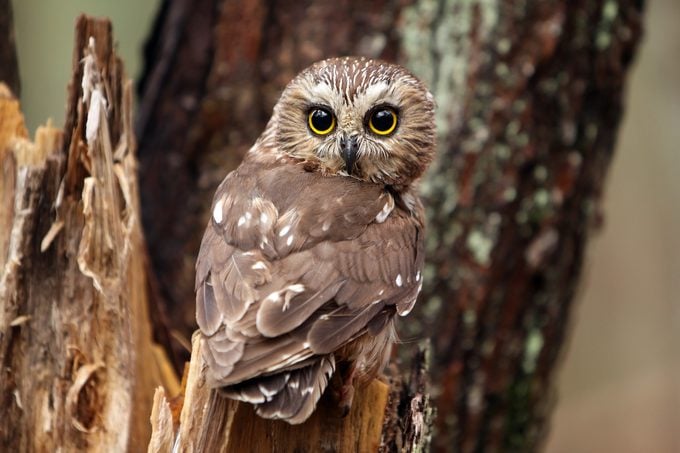
Their small size—around 8 inches tall—and large round eyes make this owl quite captivating. Northern saw-whets are named after their unusual call, which sounds like the process of sharpening a saw on a whetstone. Look for them in forests (especially dense stands of conifers) across the north and west.
Discover 13 fun facts about owls you should know.
Barn Owl
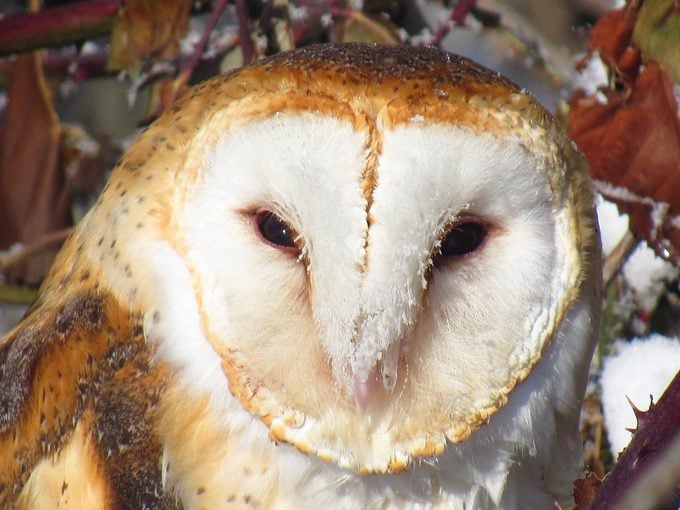
Although barn owls are found worldwide, there’s no one place where they’re particularly abundant. There are over 40 different races of barn owls, but the North American variety is the largest and makes up approximately 9 percent of the world’s barn owl population.
True to their name, barn owls nest and roost in barns, silos and other human-made structures. These types of owls can also be found living in large nest boxes, tree cavities and caves.
The skilled rodent-slayers have heart-shaped faces and are ghostly white with warm brown coloration on their backs and wings.
Check out owl shirts every bird fan should own.
Barred Owl
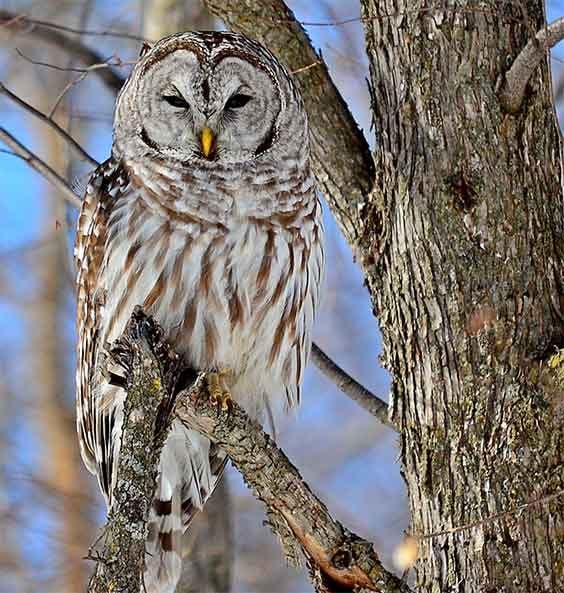
Who cooks for you? Who cooks for you allll? This is the eerie-sounding call of the barred owl, heard throughout forests in the eastern United States, southern Canada and increasingly the Pacific Northwest. As the ancient forests were cut down for lumber, the clearings and young trees that replaced them provided excellent habitat for the big barred owls.
The expansion of barred owls into Washington and Oregon is a threat to spotted owls, which depend on the disappearing old growth forest. This situation is a major conservation challenge. Meanwhile, barred owls have a threat of their own to fear. The top predator of the barred owl is the great horned owl.
Although barred owls have moved into other states, these birds are homebodies. They don’t migrate, and of 158 banded barred owls who were found later, none had moved farther than 6 miles away.
Don’t miss unique owl gifts we can’t resist.
Spotted Owl
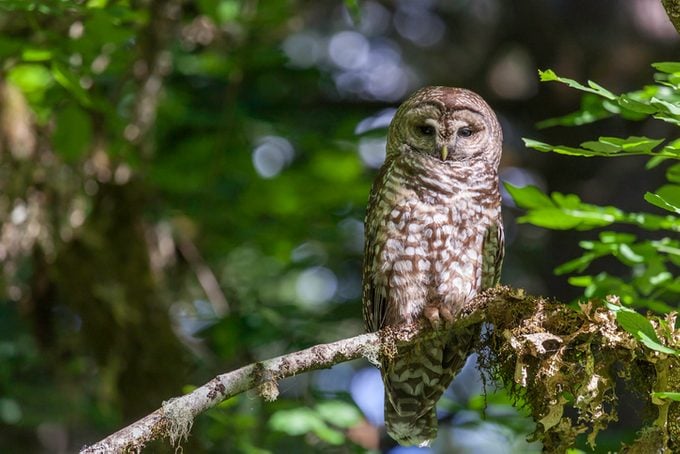
One species in particular represents the Pacific Northwest: the spotted owl. While a subspecies of spotted owl also lives in the mountains of the southwest, the heart of the species’ range is within the ancient conifer forests of the coast.
The spotted owl of the north is lovely, large and rarely seen. It relies exclusively on ancient forests for its survival. This dependency has put it at the center of the debate over logging and has made it both the poster child for conservation and a scapegoat for the loss of logging jobs. Like most such tales, the truth is murkier. Controversy aside, the spotted owl is beautiful, and birders sincerely hope it persists.
Long-Eared Owl
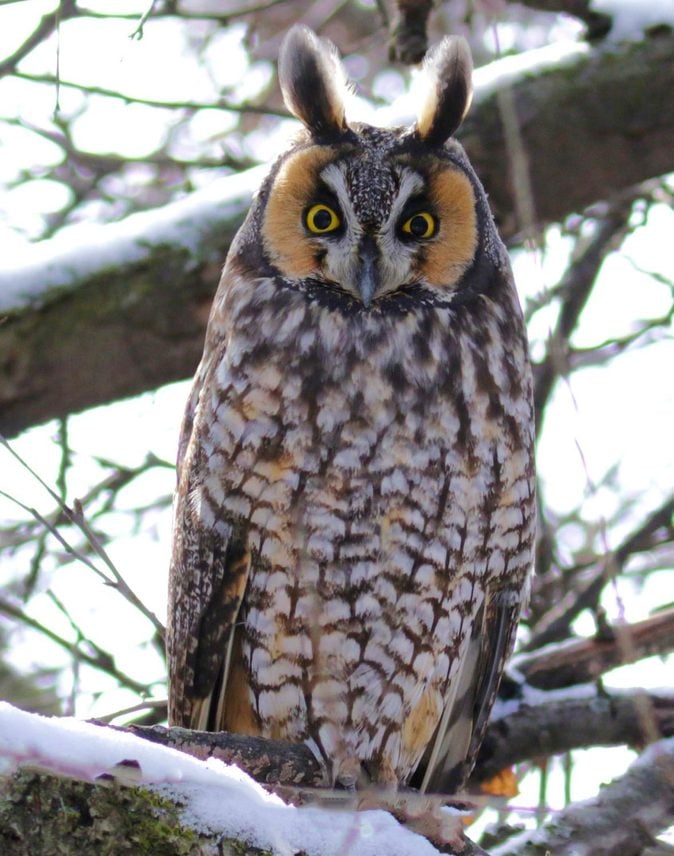
Long-eared owls are slim doppelgängers of great horned owls. But take a closer look at their markings. Intersecting vertical and horizontal barring creates a checkerboard-like pattern on their chests, while great horneds only have horizontal barring.
Long-eareds roost in thick foliage near open areas where they hunt for prey, which include voles, mice and young rabbits. Long-eared owls don’t typically construct their own nests, instead moving into abandoned ones built by other birds such as ravens, crows and hawks.
The long feathers at the top of their heads have nothing to do with their hearing; scientists believe they help the bird blend into its surroundings.
Don’t miss these adorable baby owl pictures.
Short-Eared Owl
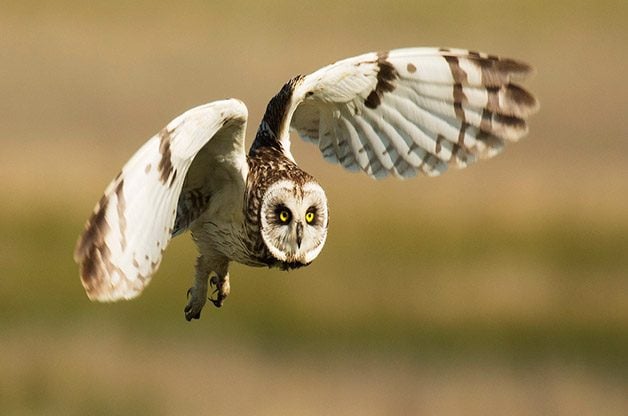
These owls live in open areas, preferring to hunt and roost in grasslands, marshes and tundra. As you might have guessed from their name, their “ears” are so short, they are difficult to see at all.
One of the most common owl species in the United States, the short-eared is also one of the few types of owls that build their nests themselves. The female of a short-eared pair scrapes a bowl-shaped nest into the ground and lines it with materials like grass and soft feathers.
Check out 6 these facts about owls in pop culture.
Screech-Owls
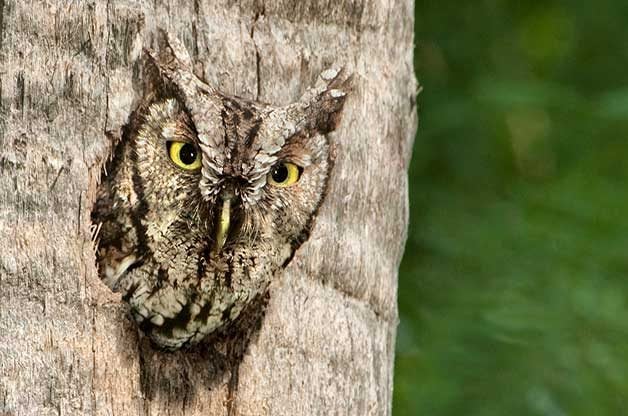
There are three species of screech-owls in the United States: eastern in the East, western in the West and whiskered along the southern borders of Arizona and New Mexico in canyons and foothills. Screech-owls are cavity-nesters and are enticed into wooded backyards with nest boxes. Eastern screech-owls can have either gray or red feathers, or a brown coloring within that wide spectrum.
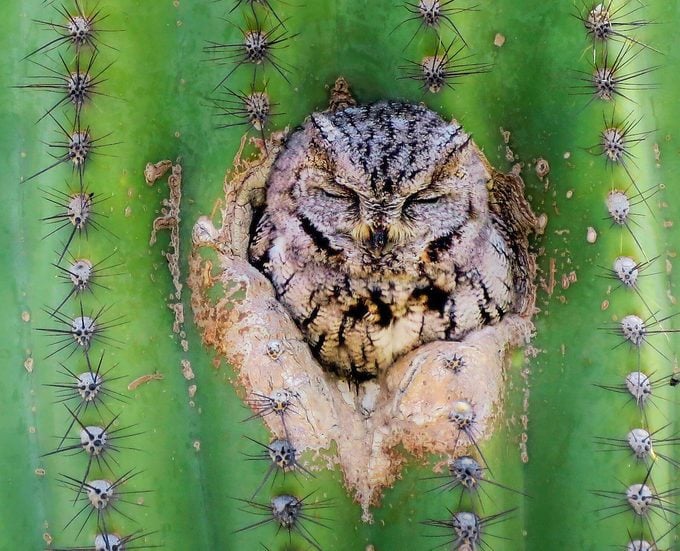
Location aside, one of the best ways to distinguish between these types of owls is by their calls. Eastern screech-owls can be heard giving their best whinnying horse impersonations. Western and whiskered screech-owls call out with hoots, toots and doots. Screech-owls eat a variety of things, from insects to small mammals.
Great Horned Owls
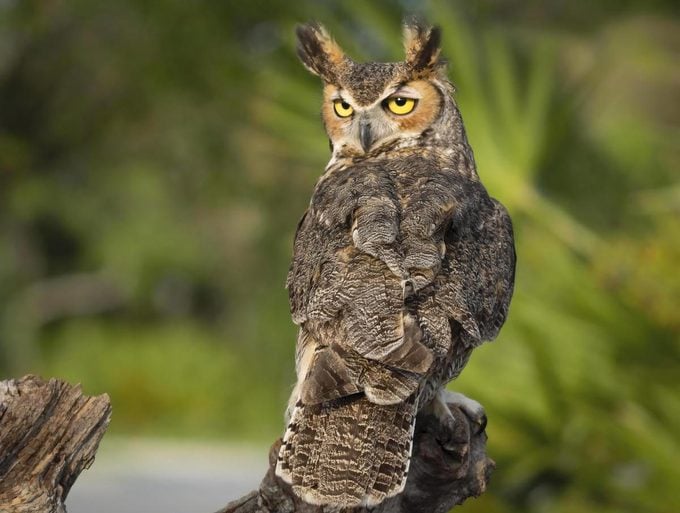
Equally comfortable nesting in the cactuses of the desert southwest as in the forests of the far north, the great horned is one of the most widespread types of owls in North America. Great horned owls are tough, taking down other large predators like ospreys and falcons with their strong talons.
These birds of prey have one of the most diverse diets among owl species and are capable of eating porcupines, scorpions, bats, skunks and even other owls. They are early-season nesters and have been known to take over prefab nests built by other birds.
Despite their name, these owls don’t actually have horns—the two telltale points at the tops of their heads are feather tufts.
Northern Hawk Owl and Boreal Owl
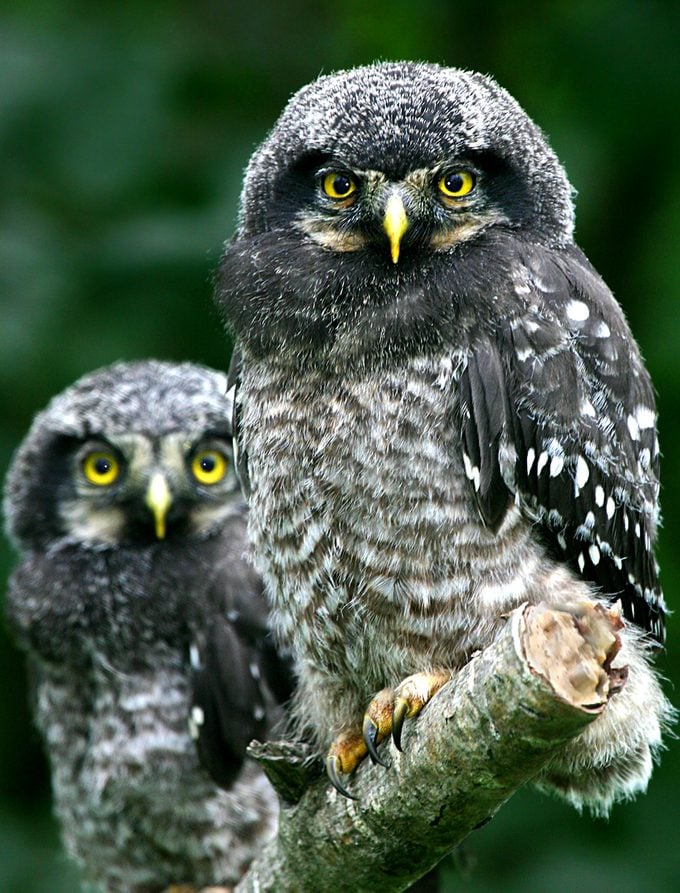
The northern boreal forest rivals the dry desert southwest for its types of owls. In addition to the great gray owl, you can spot the odd, long-tailed northern hawk owl, and also the diminutive boreal owl.
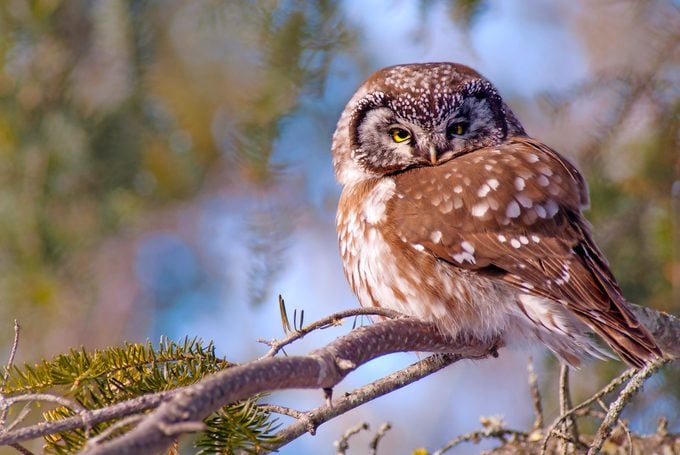
These owl species are cryptic and much sought after by birders. Despite their massive size differences, they each rely on small mammals for food.
Next, check out essential hawk identification tips for birders.


